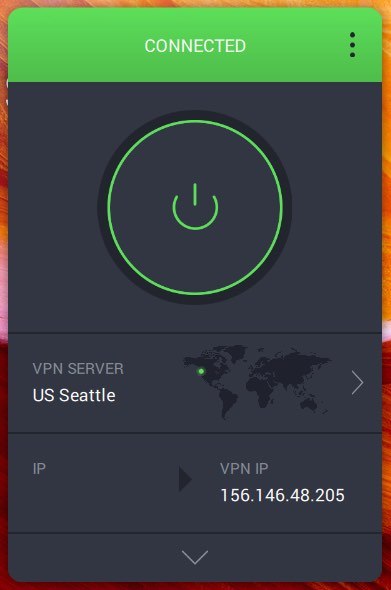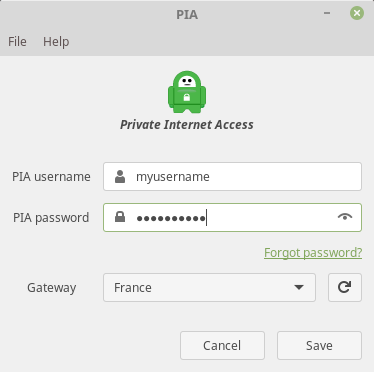

- #PIA VPN CLIENT CONFIGURATION HOW TO#
- #PIA VPN CLIENT CONFIGURATION MAC OS#
- #PIA VPN CLIENT CONFIGURATION MAC#
VPN provider: Set to Windows (built-in). Open Start Menu > Search "VPN" > Click Change virtual private networks (VPN)įrom the VPN settings page, click Add a VPN connection. When using Meraki-hosted authentication, VPN account/username setting on client devices (e.g. PC or Mac) is the user email address entered in the dashboard. Account Name: Enter the account name of the user (based on AD, RADIUS, or Meraki cloud authentication). Admin can find them in the dashboard under Security appliance > Monitor > Appliance status. Hostname is encouraged instead of active WAN IP because it is more reliable in cases of WAN failover. Server Address: E nter the hostname (e.g.com) or the active WAN IP (e.g. Click the "+" button to create a new service, select VPN as the interface type, and choose L2TP over IPsec from the pull-down menu. #PIA VPN CLIENT CONFIGURATION MAC#
Open System Preferences > Network from the Mac applications menu.
#PIA VPN CLIENT CONFIGURATION MAC OS#
The instructions below are tested on Mac OS 10.7.3 (Lion). When using Meraki-hosted authentication, the VPN account/username setting on client devices (e.g. PC or Mac) is the user email address entered in the dashboard.
Machine authentication: Preshared keys (e.g. shared secret). User authentication: Active Directory (AD), RADIUS, or Meraki-hosted authentication. Password: Credentials for connecting to VPN.įor more information regarding the configuration of VPN connections in Chrome OS, visit the Google Support page.Ĭurrently, only the following authentication mechanisms are supported:. If using Meraki authentication, this will be an e-mail address. Username: Credentials for connecting to VPN. Pre-shared key: Enter the shared secret that admin created in Security appliance > Configure > Client VPN settings. Provider type: Select L2TP/IPsec + Preshared key. Service name: This can be anything you want to name this connection, for example, " Work VPN". Admin can find them in dashboard under Security appliance > Monitor > Appliance status. Server hostname: E nter the hostname (e.g.com) or the active WAN IP (e.g. In the box that appears, fill in the information below:. In the Internet connection section, click Add connection. Click the status area at the bottom of your screen where your account picture is located. If you haven't already, sign in to your Chromebook. #PIA VPN CLIENT CONFIGURATION HOW TO#
For more information on how to set up the client VPN feature of the MX, or how to connect from other operating systems, please visit the Client VPN Overview documentation. This article will cover how to configure the VPN connection on a Chrome OS device. This allows remote users to securely connect to the LAN. You can also use the HTTP control server to get the port forwarded.Chrome OS-based devices can be configured to connect to the client VPN feature on MX security appliances.

You will keep the same forwarded port for 60 days as long as you bind mount the /gluetun directory. It can be useful to mount this file as a volume to read it from other containers, for example to configure a torrenting client. When PRIVATE_INTERNET_ACCESS_VPN_PORT_FORWARDING=on, a port will be forwarded on the VPN server side and written to the file specified by PRIVATE_INTERNET_ACCESS_VPN_PORT_FORWARDING_STATUS_FILE=/tmp/gluetun/forwarded_port. It seems to only work for port forwarding for torrenting applications, not sure why, maybe they run deep packet inspection on the forwarded port. This is not a gluetun issue, but a PIA one. ⚠️ port forwarding with PIA is not really working for some reason. It defaults to /tmp/gluetun/forwarded_port.
PRIVATE_INTERNET_ACCESS_VPN_PORT_FORWARDING_STATUS_FILE: File path to write the forwarded port number to. PRIVATE_INTERNET_ACCESS_VPN_PORT_FORWARDING: defaults to off and can be set to onto enable port forwarding on the VPN server. VPN_ENDPOINT_PORT: Custom OpenVPN server endpoint port. ⚠️ none disables the cipher and auth OpenVPN options. PRIVATE_INTERNET_ACCESS_OPENVPN_ENCRYPTION_PRESET: Encryption preset, defaulting to strong, which can be set to normal, strong or none.  SERVER_HOSTNAMES: Comma separated list of server hostnames. SERVER_NAMES: Comma separated list of server names. SERVER_REGIONS: Comma separated list of regions. VPN_SERVICE_PROVIDER=private internet access. SERVER_REGIONS=Netherlands Required environment variables VPN_SERVICE_PROVIDER=private internet access
SERVER_HOSTNAMES: Comma separated list of server hostnames. SERVER_NAMES: Comma separated list of server names. SERVER_REGIONS: Comma separated list of regions. VPN_SERVICE_PROVIDER=private internet access. SERVER_REGIONS=Netherlands Required environment variables VPN_SERVICE_PROVIDER=private internet access







 0 kommentar(er)
0 kommentar(er)
